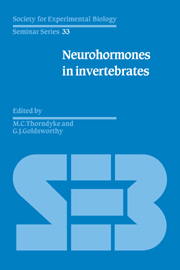Book contents
What is special about peptides as neuronal messengers?
Published online by Cambridge University Press: 04 August 2010
Summary
Nerve cells use various chemical messengers, including acetylcholine, monoamines, amino acids and neuropeptides. In the past 10 years it has become clear that there is a great molecular diversity of such messengers particularly amongst the amino acids. However, the molecular diversity of neuropeptides exceeds by far that of the amino acids. There is now evidence that in one animal species as many as 100-200 different peptide molecules may serve as neuronal messengers (Kandel 1983; Nieuwenhuys 1985; Joosse 1986).
Neuropeptides occur in nervous systems of all animals, even in the most simple such as coelenterates (Schaller et al. 1984). For many years neuronal peptides were thought to have only a neuroendocrine role. The present view however is that, in addition to their role as neurohormones, they may act as typical synaptic neurotransmitters and as paracrine or neurocrine regulators at non-synaptic sites (Buma & Roubos 1985; Nieuwenhuys 1985).
Immunocytochemical and biochemical studies provide substantial evidence that structurally related peptides are found in many different phyla. Well-known examples are insulin-like peptides and FMRFamide. An important consequence of these findings is that some of the peptides found so far may have arisen from a smaller number of ancestral molecules, possibly at the prokaryote stage (Joosse 1987).
A large part of the present volume concerns the molecular diversity and functions of neuropeptides in invertebrates. In view of the great diversity in structure and function of neuropeptides and their presence throughout the animal kingdom, the question arises as to the adaptive value of peptide variety.
- Type
- Chapter
- Information
- Neurohormones in Invertebrates , pp. 1 - 4Publisher: Cambridge University PressPrint publication year: 1988
- 1
- Cited by



